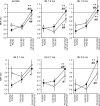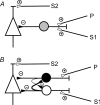Interactions between short-interval intracortical inhibition and short-latency afferent inhibition in human motor cortex
- PMID: 19752113
- PMCID: PMC2790256
- DOI: 10.1113/jphysiol.2009.179820
Interactions between short-interval intracortical inhibition and short-latency afferent inhibition in human motor cortex
Abstract
Transcranial magnetic stimulation (TMS) allows the testing of various inhibitory processes in human motor cortex. Here we aimed at gaining more insight into the underlying physiology by studying the interactions between short-interval intracortical inhibition (SICI) and short-latency afferent inhibition (SAI). SICI and SAI were examined in a slightly contracting hand muscle of healthy subjects by measuring inhibition of a test motor-evoked potential conditioned by a sub-threshold motor cortical magnetic pulse (S1) or an electrical pulse (P) applied to the ulnar nerve at the wrist, respectively. SICI alone and SAI alone had similar magnitude when S1 intensity was set to 90% active motor threshold and P intensity to three times the perceptual sensory threshold. SICI was reduced or even disinhibited when P was co-applied, and SAI was reduced or disinhibited when S1 was co-applied. These interactions did not depend on the exact timing of arrival of P and S1 in motor cortex. A control experiment with a S1 intensity lowered to 70% active motor threshold excluded a contribution by short-interval intracortical facilitation. Finally, SICI with co-applied P correlated linearly with SICI alone with a slope of the regression line close to 1 whereas SAI did not correlate with SAI when S1 was co-applied with a slope of the regression line close to zero. Data indicate that S1 largely eliminates the effects of P when applied together, suggesting dominance of S1 over P. Findings strongly support the idea that SICI and SAI are mediated through two distinct and reciprocally connected subtypes of GABAergic inhibitory interneurons with convergent projections onto the corticospinal neurons. Furthermore, dominance of S1 over P is compatible with the notion that the SICI interneurons target the corticospinal neurons closer to their axon initial segment than the SAI interneurons.
Figures






References
-
- Chen R. Interactions between inhibitory and excitatory circuits in the human motor cortex. Exp Brain Res. 2004;154:1–10. - PubMed
-
- Chen R, Cros D, Curra A, Di Lazzaro V, Lefaucheur JP, Magistris MR, Mills K, Rösler KM, Triggs WJ, Ugawa Y, Ziemann U. The clinical diagnostic utility of transcranial magnetic stimulation: Report of an IFCN committee. Clin Neurophysiol. 2008;119:504–532. - PubMed
-
- Di Lazzaro V, Oliviero A, Meglio M, Cioni B, Tamburrini G, Tonali P, Rothwell JC. Direct demonstration of the effect of lorazepam on the excitability of the human motor cortex. Clin Neurophysiol. 2000a;111:794–799. - PubMed
MeSH terms
LinkOut - more resources
Full Text Sources

